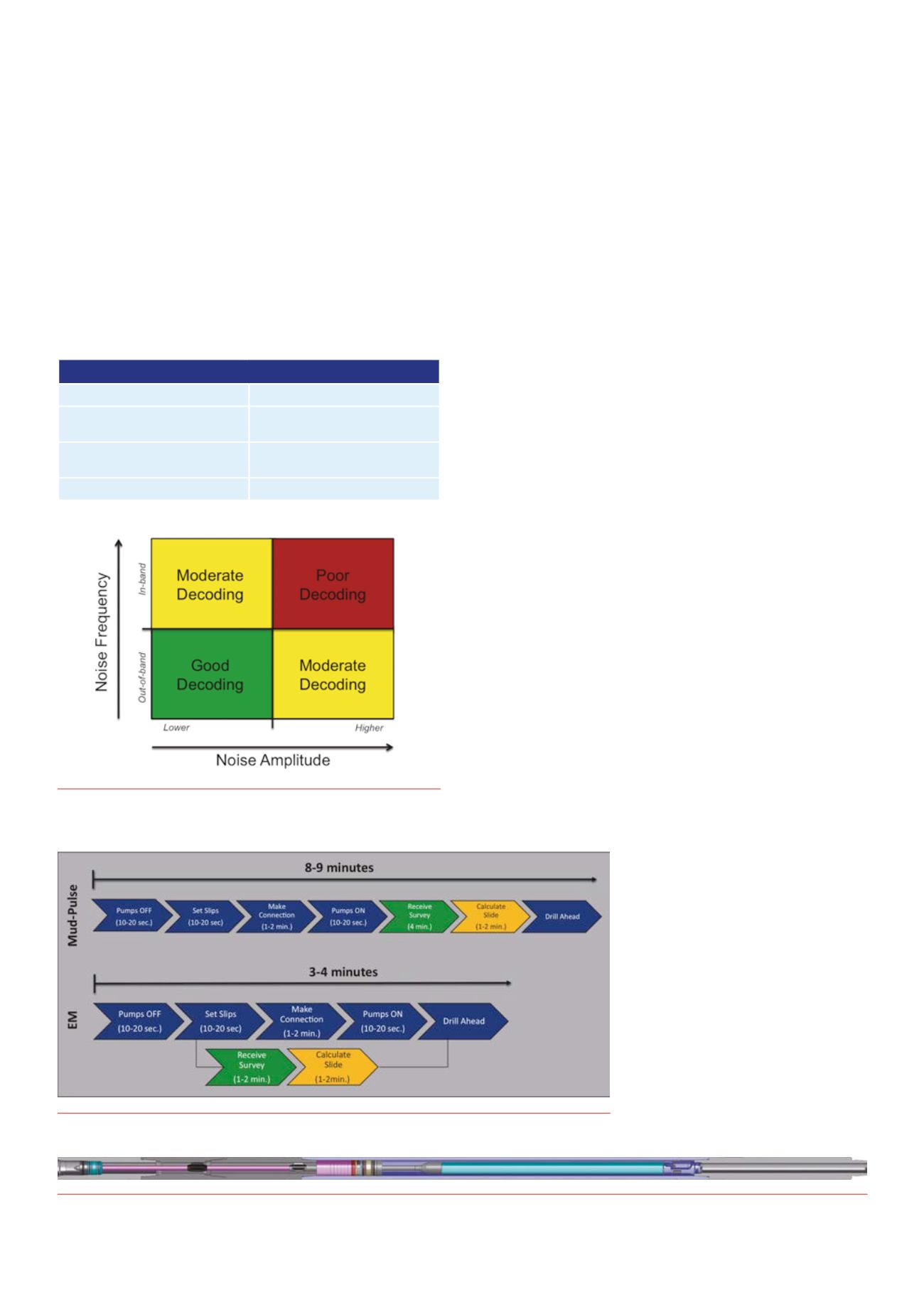
32 |
OilfieldTechnology
February
2014
Technologyadvancements:Electromagnetic(EM)
MWDsystems
Onearea thathas receivedquitea lotof attention is thedevelopment
ofnewMWDsystems foruse inunconventionalwells. EMSystems
offerpotential advantagesovermudpulsesystems in twokey
areas: system reliabilityanddata transmissionspeeds.Reliability
isalways thenumberoneareaof focus, however, additional focus
isondata transmissionspeed forgeologicalmeasurementsand
eliminationof survey times.Reducing thecost todrill thewell
continues tobeamaindriver foroperators involved indeveloping
unconventional resources. Asa resultwehaveseenan increase in
theusageofEMMWDsystems throughoutNorthAmerica. Although
prevalent inCanada forquitesome time, prior to2009 themajorityof
MWDsystemsused in theUS landmarketwerepositivepulsesystems
thatprovidedonlysurveyandgamma information. EMsystemswere
typically limited toapplicationswheremudpulsesystemsdidnot
workatall suchasairdrilling inunderbalancedor coalbedmethane
applications.
Reliability
EMMWD toolsalsoaddress twoof themajorareas thateffect
MWD reliability. Firstly, eliminationof themovingparts thatare
required foramudpulse tool tooperate isprobably the largest
factor. Aswithanysystem, a reduction in thenumberofmoving
partspositivelyaffectssystem reliability.WithanEMMWDsystem
themovingpulserparts, suchas thevalveandsolenoidormotor,
are replacedwithastationaryantennasystem. Secondly, all
mudpulsesystemsareverydependenton theconditionof the
mudsystem that isbeingused todrill thewell. Thebiggest issue
formudpulsesystems, besidesadequate flow rate, isdebrisor lost
circulationmaterial (LCM). In theUSmarket inorder todevelop these
unconventional reservoirs thebitmustpass throughpreviously
producedandsubsequentlydepleted reservoirs. Inorder tosafely
drill thesewells largeamountsof LCMare required tobeadded to the
mudsystem toprevent fluid losses to the formation.
Improveddatarates
Asopposed tomudpulseMWDsystems,which relyonmud flow
to transmit thedata fromdownhole to thesurface, EMsystems rely
on low frequency, highpowerelectromagneticwaves transmitted
from thedownhole tool and receivedanddecodedat thesurface.
Utilising theEMsignal to transmitdataversusmudpulsedata
enablesasignificant increase inoveralldata rate. Standardpositive
pulseMWDsystemsused in theNorthAmerica landmarketare
capableof transmittingat ratesof slightly less than1bitper second
(BPS).On theotherhandEMMWDsystemsarecapableof
transmittingat rates20 timesgreater than this.
Prior to2009 the relativelyslowdata rates inherentlyassociated
withmudpulsesystemswereperfectlyacceptable formost
applications. In thecaseofunconventionalswherecontinuous
surveyand logging informationare requiredat veryhigh ratesof
penetration (ROP) thesedata ratesareno longeracceptable. This is
especially trueasadditionalmeasurements to theMWDsystem toaid
inwellboreplacementanddrillingefficiency.WithanEMMWDsystem
data ratesof 10 - 20BPSarenowachievable,whichenableshigh
levelsofdata transmission fromdownhole to thesurface.
LimitationsofEMMWDsystems
All EMMWDsystemsare relianton the
conductivityof theearth to transmit
thesignal to thesurface, therefore
performanceof thesesystems is limited
togeology,whichwill vary frombasin
tobasinandoften location to location.
TheEMsignaldecreasesas thedepth
of thewell increases, asa resultof
increasedcumulative resistivity in the
earth. Additionally, thesignal strengthat
surface is relativelysmall and therefore
another challenge forEMMWDsystems
isbeingable tooperate inhighelectrical
noiseconditions. Theelectrical noise is
createdby thedrilling rig. Improvements
Figure1.
Effectofnoiseamplitudeandfrequencyondecoding
performance.
Figure3.
TheRyanAccuWaveEMMWDsystem.
Table1. Time savingsattributed toEM tool usage
Activity
Rig time savings
Eliminationof survey timeat
connection
Average4minutesper survey
DDon rig floor tobegin slidingat
pumpson2minutesper slide
2minutesper slide
Eliminationof check shots
4minutesper check shot =1hour
Figure2.
ChartcomparesthetypicalsurveysequenceMudPulseversusEMMWD.


